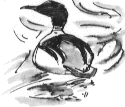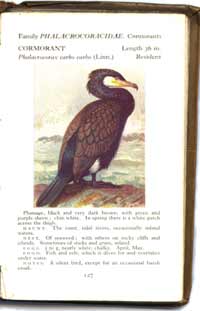
|
River BirdsMonday, 10th March 2003, West Yorkshire |
![]()
![]()
![]()
![]() Rocks | History |
Workshop |
Links | Home
Page
Rocks | History |
Workshop |
Links | Home
Page
![]()

![]()
![]() A
pair of goosanders are diving on a bend in the river
by Horbury sewage treatment works. Back in the 1970s I never remember
seeing them. Cleaner waters and returning fish must be factors in their
growing success, at least as wintering birds.
A
pair of goosanders are diving on a bend in the river
by Horbury sewage treatment works. Back in the 1970s I never remember
seeing them. Cleaner waters and returning fish must be factors in their
growing success, at least as wintering birds.

 There's
plenty of open water on the marshy field between canal and river. On the
Wyke a pair of wigeons are joined by a pair of larger
mallards.
There's
plenty of open water on the marshy field between canal and river. On the
Wyke a pair of wigeons are joined by a pair of larger
mallards.






Canada geese seem to be hanging around everywhere these
days; on the river, grazing the fields and gathering on the grass by marshy
ponds, although there weren't quite as many gathered together in one spot
as I've shown in tiled image above.
The Observer's Book of British Birds

 Two
Cormorants fly upstream, wheeling over the meander in
the river. It still gives me a thrill to see them in the valley. The bird
held a fascination for me as an eight year old when I was given my first
bird book, The Observer's Book of British Birds, by a friend
as a birthday present.
Two
Cormorants fly upstream, wheeling over the meander in
the river. It still gives me a thrill to see them in the valley. The bird
held a fascination for me as an eight year old when I was given my first
bird book, The Observer's Book of British Birds, by a friend
as a birthday present.
In this popular pocket bird book the cormorant, gets star treatment; this romantic portrait by Archibald Thorburn, (1860-1935), is the largest illustration of the 200 in the book. The bird's extraordinary appearance - in the picture it looks as if it would be about as big as I was at that time - and the wild stormy coastal setting seemed a world away to me in those dreary days in a junior school in a small smoky northern mill town.
I carried the book everywhere, just in case a Montagu's Harrier should ever turn up in the school playground, and I was horrified when it fell out of my gabardine pocket during a class football game onto the wet grubby tarmac. Wouldn't you know it; it fell open on the golden plover page, which still bears a grubby mark.
I'm sure that it was images like this that first gave me the feeling
of excitement that I still have when I visit seabird islands. I'm glad
that today that the cormorant can regularly be seen within a mile of the
old school yard. ![]()
![]() Next page |
Previous page | This
day in 2001 | This month |
Nature Diary |
Home
Page
Next page |
Previous page | This
day in 2001 | This month |
Nature Diary |
Home
Page
![]()